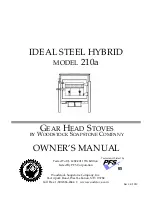
Stovepipe (Connector Pipe):
Connector pipe is either single wall (sheet metal) or double wall (sheet metal outer pipe with a stainless steel inner
pipe). We strongly recommend 22 gauge pipe (26 or 28 gauge is too thin for use with a woodstove). The connector pipe
should be 6 inch diameter to match the flue collar of the stove. If your connection to either a masonry chimney or prefab-
ricated chimney system is more than 8 feet tall, we recommend the use of double wall connector pipe. If you need to
reduce clearances for your connector pipe installation, double wall connector pipe would be recommended. All pipe con-
nections, including at the flue collar, must be secured with screws.
DO NOT USE GALVANIZED SINGLE WALL PIPE.
Connector pipe is designed to connect your stove to your masonry lined or approved prefabricated chimney system.
CONNECTOR PIPE SHOULD NEVER BE USED AS A CHIMNEY AND SHOULD NEVER PASS THROUGH A
COMBUSTIBLE WALL, CEILING, WINDOW, CLOSET, OR ROOF.
At the point where your stovepipe meets the
chimney, you must either vent into a masonry chimney with approved non-combustible transition, or a prefabricated
chimney system with a specially designed transition piece.
FIREPLACE INSTALLATION
Your Model 210 Ideal Steel Hybrid Woodstove has variable height legs, giving you
a greater range of flue heights for ease of installation when venting through an existing
fireplace. The variable height legs have a range of 5”. The height adjustment is in 1”
increments. The centerline height of the rear flue exit at the lowest leg height is 24.5”.
Installing the Ideal Steel Hybrid soapstone stove in a fireplace setting is a great way to
enjoy the view of the fire, while greatly increasing the efficiency and reducing heat loss
to the fireplace chimney.
PLEASE NOTE: You cannot have an ash pan if you are set-
ting the stove to 30.5” .
We do not recommend placing the stove inside the fireplace, as it would make rou-
tine maintenance such as cleaning the combustor more difficult, and much of the
heat radiating off the stove would not circulate into the room.
The preferred method for installing a stove in front of a fireplace is by running
a stainless steel ‘flex’ liner down the chimney, connecting it to the stove at the fire-
place. Chimneys with large flues should be relined to achieve proper draft. If the
chimney does not have flue tiles or if the tiles are cracked or compromised, an
additional insulating material must be used.
It is important that there be a secure connection between the stove and the flue
liner. It is
NOT
acceptable to simply install a plate in front of the fireplace and run
a stovepipe through it. The stove pipe must connect with the liner for a continuous
outlet to the top of your chimney.
Stainless steel flex liner kits come in a variety of lengths and are readily avail-
able. These kits include a flexible stainless steel pipe, tee with snout & clean out, a
block-off plate for the top of the chimney, and a cap. Please contact Woodstock
Soapstone Company for more information on these kits.
ALWAYS FOLLOW
THE SPECIFIC MANUFACTURER’S INSTALLATION INSTRUCTIONS.
If the fireplace surround is clad in wood trim, the proper clearance to a com-
bustible will need to be maintained. Please refer to the clearance charts on pages
7-10. An unprotected wood mantel needs to be a minimum of 30” from the top of
the stove. If a mantel shield is installed that clearance can be reduced to 12”.
DO NOT VENT YOUR WOOD STOVE THROUGH A FACTORY BUILT FIRE-
PLACE UNLESS IT IS SPECIFICALLY LISTED FOR SUCH AN INSTALLA-
TION
. Most factory-built fireplace chimney systems are only rated to 1,700° F,
which is not sufficient for a freestanding wood burning stove.
Cap
Top Plate
Stainless
Liner
Cleanout
Tee & Snout
Components of a standard liner kit:
Tee with clean out& snout, stainless
flex liner, top block-off plate & cap.
5
Ideal Steel Hybrid shown
variable height legs.
Side Support Rail
Side Fender
(cover)










































